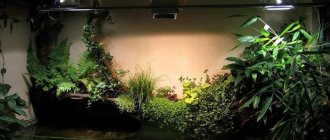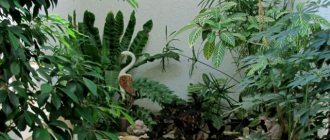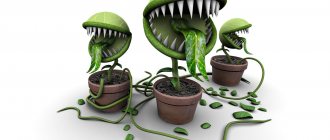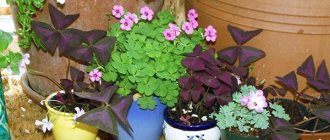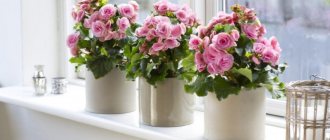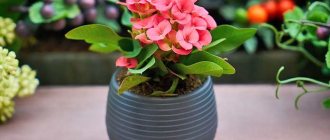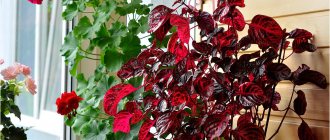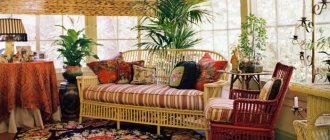Lighting needs of plants
Most indoor flowers need good lighting to grow and turn green. Therefore, owners of apartments with windows facing north or east find it difficult to choose indoor green residents that will grow and bloom well even in the shade.
Look at the photos and names of indoor seedlings that will grow in the most shaded corner of the house and not suffer from lack of sun.
These shade-loving plants are suitable not only for home cultivation, but also for decorating shaded terraces and balconies. Among them there are ampelous, flowering and deciduous beautiful specimens.
Most shade-loving plants tolerate a lack of light and grow even better in the dark or in places with diffused light. Shade-tolerant plants can be grown on a “northern” windowsill or at a distance from a lighted window.
Shade-tolerant flowers grow a little slower, but never lose their chic appearance.
If it seems that there is light in the apartment, the light intensity here is still insufficient. Illumination does not remain constant even in the brightest room; it changes throughout the day. Often the level of illumination depends on obstacles in the form of trees and nearby buildings blocking sunlight.
The illumination of the rooms also depends on the seasons and the location of the windows:
- Sunlight pours into the apartment almost all day through the southern windows.
- Windows that “look” to the east most often catch sunlight only in the mornings.
- Western windows receive more light in the late afternoon.
- Windows facing north receive almost no direct light, but they can have indirect light throughout the day.
Shade-loving indoor vegetation will feel good both on the northern window and in the back of the room.
With the help of shelves, vertical supports, hanging flowerpots, you can decorate any interior with shade-tolerant varieties.
Top 10 most unpretentious indoor plants for home and office
Unpretentious plants survive well at any level of air humidity. In addition, they are not particularly affected by the degree of illumination of the room where they are located. The following varieties of flowers can easily adapt to almost any living conditions.
Monstera
Monstera is a plant with large reserve leaves . Belongs to the group of philodendrons. The flower can be placed in any corner of the room, even far from the light source - and it will still continue its life.
Zamioculcas
Zamioculcas is a succulent that can accumulate moisture in the vegetative mass or trunks . Main characteristics:
- Does not require frequent watering.
- Can go without water for a long time.
- Unpretentiousness to lighting or air humidity.
At the same time, the plant has a rather impressive appearance, so it is perfect for both home and office.
Dracaena
These indoor flowers prefer a room with a high level of humidity. But even if this is not provided to them, they will not die. Dracaenas are very hardy plants . The maximum that can happen to a flower due to lack of moisture is yellowing of the tips of its leaves.
Hovea
Howea is a herbaceous palm . Culture is one of the most favorite office plants among gardeners, although it is also perfect for landscaping at home. The plant has such an attractive appearance that it can decorate any corner of the room. And if you hang a flowerpot with it above a sofa or armchair, you will get a cozy place for relaxation.
Bamboo
Bamboo is highly resistant to cold air and drafts, but:
- It needs a lot of diffused light.
- It needs regular watering.
- The plant does not tolerate drought and space.
Otherwise, indoor bamboo is unpretentious and easily adapts to new living conditions.
Chlorophytum
For an office worker who does not have a lot of free time to care for ornamental plants in the office, chlorophytum is perfect. This flower grows and develops in any conditions.
For chlorophytum, the optimal temperature is 18 °C, and the frequency of watering does not matter, as does air humidity. You can also feed the plant infrequently.
Dieffenbachia
This is an unusually beautiful plant, whose homeland is considered to be the tropical part of America. The flower does not tolerate heat and bright light, so it cannot be placed on a windowsill on the south side. Also, do not expose it to drafts and temperatures below 15 °C or above 25 °C.
Aloe
The most classic option is aloe. Growing it on a windowsill is very simple; the flower does not require special care. In addition to its attractive appearance, the plant also has many beneficial properties. And you can keep it not only in an apartment, but also in an office space.
Also read: Which indoor plants cannot be grown at home, reasons, list with photos
Crassula
Crassula, Crassula, money tree - these are all names of one plant. This is not only an unpretentious flower, but also a “magnet” for attracting money, good luck and prosperity. Of course, according to Feng Shui experts . The plant does not require special care; it is unpretentious to watering and air humidity.
Tradiscantia
An ideal “indoor flower for the lazy,” as it can survive even in extreme conditions. Tradiscantia is an ampelous plant with beautiful bright leaves. Tolerates both low and high temperatures, but needs good lighting. Without it, the plant will not die, but will lose its decorative appearance. Moreover, the plant tolerates even the most serious mistakes in care, and can do without it for a long time . It reproduces very well. Place the branches in water, and after 10 days they will sprout roots.
Blooming shade-tolerant houseplants
Many residents of city apartments want to breed only flowering varieties of green pets. Beautiful buds decorate the room, lift your spirits and provide wonderful moments of relaxation after a hectic day at work.
Begonia
The most favorite flower is the unpretentious beauty begonia. Even partial shade will not prevent it from blooming lushly. If a shade-loving begonia is placed in bright sun, its colors will begin to fade and the plant will lose its attractiveness.
When exposed to light, the bright green carved leaves of the beauty will begin to fade and become smaller, and soon the entire bush will become inconspicuous.
In indoor plant growing, the following unpretentious varieties of begonias have become the most popular:
- "Rex"
- "Drege"
- "Odorata"
- "Mason".
Violet
It is difficult to find a more popular flower than the Usambara violet. It blooms almost all year round with beautiful colorful bouquets. This is the best flowering perennial for the home.
Pots take up little space, so they can occupy any free corner with soft, diffused lighting. The western and eastern windowsill for shade-loving Saintpaulia is the best place for development and flowering. And under the burning rays of the sun, she can die from burns.
Anthurium
Anthurium is valued for its spectacular flowers that will decorate a darkened corner of the apartment for several weeks. This plant prefers diffused light, warmth and good care.
Anthurium will do well in summer at an air temperature of 23°C, and in winter 17°C. This capricious, shade-loving culture does not tolerate bright sunlight at all.
Clivia
Clivia is a luxurious exotic plant that blooms 2 times a year (in early spring and late autumn) and can decorate the shady side of an apartment.
The house plant is notable for the fact that during flowering it produces succulent flower stalks to a height of 27 centimeters. In this case, a large number of bright buds can form on the peduncle: from 12 to 25 pieces.
To see a flower in all its splendor, it is necessary to create conditions: warmth, regular watering, soft diffused light. Light shading of clivia is also not dangerous. The direct rays of the hot sun are more dangerous; they burn the beautiful leaves of the shade-loving flower crop.
Cyclamen
Unpretentious cyclamen will bloom even in light partial shade, but in the sun it will be very bad.
Cyclamen is loved for its spectacular blooms with large flowers that look like butterflies or bells. The color of the flowers can be white-pink, dark burgundy, and often purple-violet.
Popular varieties of cyclamen:
- Kossky,
- Persian,
- Cypriot.
Fuchsia
Fuchsia is a magnificent flowering perennial prized for its long-lasting blooms. It can grow well in light, partial shade and shade. The color of the buds can be creamy-pink, lilac-violet and red. Two-color large fuchsias are very popular.
Dicentra
It is a popular garden plant but often grows in the home greenhouse. Grows best in shade and partial shade. The height of the home shade-loving dicentra is 30-50 centimeters. It can bloom for several months, producing small heart-shaped flowers.
The color of the hearts varies from white-pink to purple-pink.
Calathea Crocata
This unpretentious crop produces beautiful flower stalks with yellow lights above dark green foliage. Loves warmth and spraying, but is afraid of drafts.
Non-flowering houseplants
Non-flowering plants are plants that are grown for their beautiful leaves or generally for their attractive appearance. The leaves of such plants can be of different colors and shapes. Typical representatives: ficus, dracaena, succulents.
Small indoor flowers
Ficus
One of the most interesting representatives of non-flowering plants is considered to be indoor ficus. Surely, those who were lucky enough to vacation in any Mediterranean country have seen large glossy leaves on interesting spreading trees. The indoor version of the ficus also looks very elegant. In nature, there are many species of this plant; there are approximately 20 indoor varieties. The most famous is the rubber-bearing ficus , which is rightfully considered a long-liver and, with proper care, can please the inhabitants of the home for about 50 years.
Although ficus trees are relatively easy to grow, they do have some special needs that you'll need to pay attention to. Here are a few things to consider when considering growing a ficus as a houseplant.
- Light. Ficus loves bright, indirect sunlight and lots of it. Your plant will enjoy spending time outside in the summer, but protect the plant from direct sunlight if it is not acclimatized. In winter, keep the plant away from drafts and do not allow it to remain in a room with a temperature below 10-16°C.
- Watering. Ficus needs constant but moderate watering throughout the growing season, with dry periods in winter. Make sure the soil is just moist and not dry or soggy, but reduce watering in winter. Your plant will most likely lose leaves during the winter drought. Hanging ficus trees are especially susceptible to over- and under-watering. Foliar sprays can provide additional moisture during droughts with less threat of root rot. Well-draining soil is essential to keeping these plants healthy.
- Transfer. Ficus grows quickly and can easily become too large for your home if you repot it frequently. Limit potting to once every two years to control your plant's growth.
Ficus rubbery
Ficus benjamina, or weeping fig, is also popular. It's known for dropping its leaves and is generally easy to grow—as long as you don't move it. Ficus prefers to stay put. In fact, the seemingly simple and harmless act of moving it from one corner of the room to another, or even a few meters for that matter, can cause it to lose its leaves.
Decorative deciduous shade-tolerant plants
In order not to leave the dark corners of the house without greenery, you need to choose the most shade-loving indoor plants and decorate the interior. It’s good that among the plants you can choose those that can turn green even in low light without losing their beauty and attractiveness.
They may not bloom in lush bouquets, but they can boast of the beauty of their foliage with different shades of green.
Chlorophytum
If you want to decorate the deepest parts of the room, then choose deciduous varieties. It should be borne in mind that even the most shade-loving indoor plants can only be distanced 2 meters from northern windows and 3 meters from windows located in other parts of the world.
Shade-loving chlorophytum is suitable for landscaping the depths of rooms and offices. Today, so many varieties of this modest plant have been grown that even flowering specimens pale in comparison to its beauty.
Aspidistra
Aspidistra is tall, striking in the beauty of its leaves covered with white powder. But if you want to grow aspidistra in a dark corner, then it is better to choose bushes with a pure green color, otherwise the white haze will disappear.
This plant may have inconspicuous flowers under the leaves, but they do not play a role. The flower is decorated with large succulent leaves.
This is one of the more shade-tolerant houseplants and can be placed in a very dark location. Another advantage of aspidistra is its amazing unpretentiousness. True, in winter the plant will need to reduce the temperature to 12-15 degrees.
Aglaonema
Aglaonema can have leaves of different shapes and colors. Reaching a height of 30-60 cm, the plant forms a beautiful bush, where the stems are not visible at all behind the foliage.
Thanks to its shades of silver and green, the plant always looks very elegant, even in the darkest corner of the room. With very good care it can please you with flowers.
Alocasia
Alocasia captivates with the beauty of its very large leaves. The spectacular beauty attracts attention with the veins of cream-colored foliage arranged on the plate in the form of a mosaic. Can grow from 50 cm to 2 meters.
Capricious alocasia is not demanding in terms of lighting, but is picky about care. You can't reduce humidity, but you can't increase it either. The same requirements apply to temperature and watering.
Soleirolia
Soleirolia is a creeping plant adapted to grow at home. In nature, soleirolia grows, as a rule, in the darkest places, on rocks, in the seams between stones. As a result, curly greenery will decorate any interior.
Multi-row sickle-shaped
The multi-row sickle-shaped plant feels good at a distance of 2-3 meters from the window. Reaching a height of 50-70 cm, the multi-row plant produces very beautiful glossy openwork leaves.
The main disadvantage of a multi-row plant is its love for cool temperatures: about 10 degrees in winter, and 16-18 degrees in summer. If you keep the soil moist and spray frequently, the multi-row plant can adapt to higher temperatures.
Ampelous plants
Ampelous plants can enliven any corner of the house. They hang so beautifully from the walls of pots or wrap around supports that even non-blooming specimens look fresh and impressive.
Indoor grapes
Tetrastigma Voignier, or indoor grape, is one of the top shade-loving vines.
The fast-growing climbing vine has become famous for its juicy, large leaves with a jagged edge. The height of the plant can reach 4 m. The climbing perennial beautifully decorates not only shady walls, but also any vertical support. Suitable for decorating a living screen.
Unpretentious, almost does not react to low air humidity, but loves fresh air. Easily tolerates pruning.
Ivy
Hedera or ivy is an elegant decorative indoor flower with spectacular carved foliage. Loves shaded places and does not tolerate bright lighting. In the sun, the leaves of the hedera fade and lose their beautiful emerald color.
Epipremnum
Epipremnum is a green vine used to decorate walls in the shade. It grows very quickly, occupying the entire wall with climbing vines up to 6 meters long.
The shade-loving houseplant can take root in any conditions and requires almost no attention. Watering and fertilizing are all the flower's requirements.
Tetrastigma
Tetrastigma is one of the spectacular climbing plants. You can decorate any room, even a gazebo built among the trees in the garden.
In indoor floriculture, ampelous varieties such as Tetrastigma lanceolata and Voignier have become popular. These vines do not care what kind of light there is in the room. They turn green beautifully in low light. In bright light, their emerald greens, on the contrary, turn very pale.
Tradescantia
Tradescantia is an evergreen climbing perennial with long shoots covered with small leaves. The varieties of this crop amaze the imagination with the colors of their foliage, from emerald, variegated, tricolor, to purple.
With good care and growing in favorable conditions, it can please you with very beautiful flowers.
Tradescantia is one of the most popular hanging plants. It requires almost no maintenance, and the resulting curly stems will quickly decorate any home greenhouse.
They tolerate shade well, even light drought. Under the hot rays of the sun, Tradescantia leaves, as a rule, fade and wither.
Indoor plants for dark rooms
Not all indoor plants are light-loving. There are also those who feel great in shaded rooms, and even cannot tolerate too bright colors. In this case, you can choose the appropriate option from the following list of indoor flowers.
Begonia
There are more than 100 varieties of begonia. Each of them is good in its own way, but tuberous and root varieties of the crop are used to decorate rooms and office spaces. This flower:
- Tolerant to growing conditions.
- Feels good in the shade.
- Does not require frequent watering.
Begonia is perfect for beginner gardeners.
Spathiphyllum
Popularly called “female happiness,” this is a beautiful decorative indoor plant with white flowers. It does not require specific care and grows well in the shade, but it loves moisture, so the soil should not be allowed to dry out. The optimal humidity for spathiphyllum is 50% and above.
Also read: Venus Flytrap floral predator
Freezea
Quite a bright, extraordinary plant from the Bromeliad genus. It has a colorful peduncle, shaped like the feather of a fairy-tale firebird. The plant blooms in partial shade, but loves high humidity and temperatures not lower than 22 °C. In general, the flower is unpretentious.
Clivia
A flower from the Amaryllis family. Loves shaded places and sufficient moisture. The flowering period usually occurs in February and March. The flower does not require special care.
Streptocarpus
Streptocarpus is a representative of the Gesneriev family. The plant looks quite unusual and has a specific color. This flower will decorate any shaded room, and there is no need to fuss around it - it adapts well to different environmental conditions. Blooms profusely.
Miltonia
A very beautiful flower, which became the basis for the creation of equally interesting hybrids . It loves high humidity, so it needs regular watering. Blooms fully in the shade.
Palm and large-sized
People have always been attracted to large plants that can be grown at home. Any large flower is a real pride for its owner.
If space allows, then all owners of a home greenhouse try to acquire a large green pet.
Hamedorea
Hamedorea is an elegant palm tree. In a pot it can grow over a meter in height.
An amazingly beautiful palm tree with airy leaves, like the feathers of an exotic bird. In the wild it also grows in the shade and generally does not tolerate the bright rays of the sun.
Hamedorrhea is demanding to care for. Prefers warmth, frequent misting and turning the pot opposite sides to the light so that its luxurious leaves grow properly.
Aucuba japonica
Aucuba japonica from Japan moved to our flower growers. An amazing flower, the leaves of which are covered with golden droplets, rises to a height of 1.5 meters. For its golden design it was called the “golden tree”.
Aucuba is a poisonous plant, so care must be taken when pruning. With the help of pruning, the tree can be given any shape. Like all tree-like species, it lives for decades.
Loves dense shade, moderate watering and humidity. Does not respond to sudden temperature changes.
Ficus benjamina
Ficus benjamina - a luxurious two-meter exotic plant is often used in phytodesign. Loves space, soft diffused lighting and good care.
Sansevieria
Sansevieria is an unpretentious, attractive plant that is often found in home greenhouses. A flower with an original “marble” foliage color is suitable for both an apartment and an office.
It purifies the air of toxic substances that are released during the operation of various electronic equipment, while releasing oxygen. This process most often occurs in the dark or at night, so it can be placed in the bedroom.
Ferns
If you need to add greenery to a shaded corner of your apartment, you should put a fern on the shelf. A beautiful green bush hanging down will decorate any interior.
Ferns in nature grow in the shade of tall trees, so low light for them is not an obstacle to the lush growth of carved greenery. It is recommended to place pots with ferns on the western, eastern or northern side of the house. These indoor flowers have several types.
One of the most decorative ferns is considered to be the adiantum with delicate, lush green leaves.
Ferns are planted in a tight container and watered abundantly. The best watering is to place the flowerpot in a basin of settled water, and then allow the excess moisture to drain.
Loves spraying, good ventilation and shaded areas. Sunburn can kill you.
What are succulents: videos and names
Succulents have excellent decorative properties. With their help you can decorate even a poorly lit interior. Succulents do not require high temperatures to thrive, but humidity levels do need to be high. Therefore, it is advisable to install some kind of fountain or aquarium next to the plant.
Detailed guide - Succulents: types and names with photos
There are many types of succulents. The most famous are aloe, agave, and wild Kalanchoe. But the most popular and famous are, perhaps, cacti. You can learn how to plant succulents by watching the video
Conifers
Small thujas, evergreen coniferous trees, have become widespread in indoor floriculture. The beneficial advantages of thuja are known: endurance, unpretentiousness, beautiful appearance, and the ability to purify the air of toxins.
Thujas do not need bright light. And the sun's rays seem to burn out the emerald color of the tree, depriving it of its attractiveness.
Fruit houseplants: photos and names
Avocado
The plant belongs to the Laurel family, genus Perseus. Having a rather unattractive appearance, it has excellent taste and is a very healthy dietary product - it does not contain harmful fats. You can grow it from a seed yourself.
Pomegranate trees
Dwarf species of are used for growing indoors . They grow no more than 1 m in height, bloom for quite a long time and form small but very tasty fruits.
Lemons
Buying lemons is not a problem today. But a small tree growing in an apartment brings joy to all its inhabitants. After all, the lemon smell comes from just one blooming flower. But the appearance of small fruits, painted bright green, delights both the apartment residents and their guests.
Read more: Lemon tree at home: care
Caring for shade-loving plants
Shade-loving and unpretentious crops also require care.
Caring for green pets:
- Place away from direct sunlight. Can be placed on shelves, cabinets, tables in corners.
- When planting in a pot, use fertile soil for indoor flowers. Do not feed for 3-4 months.
- Feed with complex fertilizers.
- You can clean it from dust in the shower.
- Protect from drafts.
- Water as the soil dries.
- Spray with a spray bottle, maintaining humidity.
Options for decorating an apartment using shade-loving plants
Using shade-tolerant houseplants when decorating apartments, you can conduct experiments, or you can take the advice of phytodesigners.
Techniques for decorating space by room
- Hallway: single tall ficuses, palm trees or group compositions in the form of a plant mosaic will look beautiful here.
- Kitchen: the “place of refuge” for most flowers is the windowsill. Here you can plant chlorophytum, violets, and sheflera. Cissus and Tradescantia will happily grow on cabinets. It is best to place the “Pike Tail” in a corner on the floor or near the radiator.
- The living room is an area of daring imagination and limitless experiments. A large room is the best place to create a green screen or a cascading composition, where a tall tree is placed in the corner, then medium-sized specimens, and a small large-leaved flower completes the group.
- The bedroom is not a place for a lot of flowers. A shelf is placed here, and small flowerpots with flowers are placed on it.
- Bathroom - there are many shelves here that are filled with small flowers. You can put the most moisture-loving specimen in the corner. Here you can use very small-sized flowers, which will need to be periodically exposed to sunlight. A small flower is easier to transfer to light, so they are suitable for decorating a bathroom.
Location of flowerpots
To change the interior of the room every time, try planting compositions of indoor flowers in flowerpots. A tall flowerpot looks beautiful next to flowers in small pots of the same color.
An original stand with flowerpots for the living room.
Flowerpots with flowers can be used to decorate a gazebo, the entrance to a house or a terrace.
Shade-loving indoor plants for the hallway
Most often, the hallway is left without green decoration due to constant darkness. But there are shade-loving indoor plants specifically for the hallway.
Flowers located in the space of a dark hallway give it a cozy and well-groomed look.
What plants are able to grow in conditions of low light?
The most unpretentious foliage and ornamental plants have foliage of unusual shape and color, so they will decorate the darkest corridor.
When decorating a hallway, you can’t do without evergreen sansevieria, which was given the funny name “mother-in-law’s tongue.”
Exotic shefflera does not require special development conditions. An elegant deciduous bush, up to 2 meters high, can be installed in the corner of the hallway.
Ferns of all kinds will also decorate a dark corridor.
Aglaonema - suitable for growing in low light areas. However, it does not tolerate dry air, so it should not be placed near heating radiators.
Palm trees and dracaena can also be placed in the hallway. In addition to deciduous specimens from the world of tropical flora, many flowering plants can turn green and develop in a dark corridor.
Spathiphyllum is an evergreen plant with glossy, rather large leaves and oblong snow-white flowers. This exotic is a real find for decorating dark corners of the apartment.
You can’t do without chlorophytum either. It will not only decorate the hallway, but also rid it of harmful substances that are emitted by the cabinets in this part of the house. The walls of the corridors will be decorated with graceful hedera and tradescantia vines.
Bonsai trees will fit organically into the space of dark corridors:
- carmona,
- barberry and
- pyricantha.
Cacti and succulents are another group of plants that can decorate a dimly lit hallway and other rooms.
